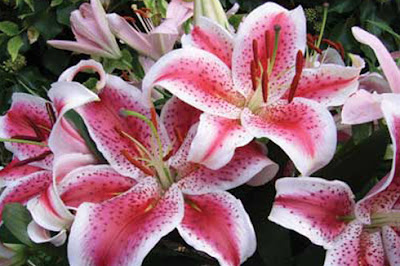Plants that are toxic to your cat and what to do if ingested
Mandy Cooper
PLANTS THAT ARE HAZARDOUS FOR CATS AND HOW TO TREAT THEMCats will chew on plants, and because they love to climb and explore, it's difficult to keep plants out of their reach. Therefore, it you want to keep plants inside the house or let your cat outside, you need to be able to identify plants which are potentially dangerous. If in doubt, it's better to remove plants from your home. If a plant is poisonous, assume all parts of the plant are poisonous. Many toxic plants are irritants causing inflammation of the skin, mouth, stomach, etc.
Since many plants are irritants, especially for the gastrointestinal tract, most symptoms seen will be as a result of inflammation such as redness, swelling or itchiness of skin and mouth. Some symptoms to watch out for is difficulty breathing, drooling or difficulty swallowing, vomiting, diarrhea, excessive drinking and peeing, fast, slow or irregular heartbeat.
Most cats are picky and are careful about what they eat. Poisoning in cats is generally rare. It is the young or inquisitive kitten that is more at risk of eating harmful plants, particularly household ones. Boredom also has a part to play. When a kitty is kept indoors, hazardous plants should be removed from the environment. All plants, even grass, can have an irritating effect on a cat's gastrointestinal system causing him or her to vomit. Given the opportunity, though, cats like to nibble on grass.
Particularly dangerous plants are dieffenbachia (dumb cane) and lilies (popular in bouquets and flower arrangements). While it's easy to remove household plants, outdoor plants are not so simple, but if you are aware of which plants are dangerous to cats, you can remove these from your garden. Make a list of all plants as this can help vets if you suspect your can has been poisoned. You can also ensure that any new additions to the garden are safe. Most garden centers or nurseries label plants that are toxic.
Plants are grouped into 3 categories:
1. Poisonous
2. Toxic if eaten
3. Harmful if eaten
Poison Ivy is a classic example of a poisonous plant, and category B plants should be avoided. If you like gardening, never leave hedge clippings or uprooted plants near cats. Sap from damaged stems can cause skin irritation as well as be being poisonous. Bulbs, rhizomes, and roots can be the most dangerous parts of some plants.
What to do if you suspect poisoning or you see your cat eating a hazardous plant
Diagnosis depends on to a large extent on the background you provide your vet. To accurately determine your cat's health condition, you will need to list your cat's symptoms and how long they have been going on. A vet should be contacted immediately if your cat suddenly collapses, has repeated vomiting, severe diarrhea or shows signs of excessive irritation of the skin of the mouth or throat. Cats that are lethargic and off their food for a day or more should seek professional help immediately too. Take your cat to the vet with a sample of the plant or a plant label if you have one.
This will help the vet to find a treatment or antidote to the poison. Make a note of the time of eating and any symptoms. Several days can pass between eating the undesired plant and the effects. Contact with leaves of food plants such as tomato, strawberry, rhubarb, parsnips, carrot, celery, marrow, and cucumbers may all affect cats causing them to sneeze and have eye problems.
The following is a list of plants that are potentially poisonous or harmful to your cat when eaten. It is often the fruit or seeds of plants that are potentially dangerous. Deadly Nightshade is a common plant that carries toxic berries and only a small quantity of these need to be eaten for it to be fatal for your cat. In daffodils, bulbs in the plant cause harm when eaten.
A final word: do not induce vomiting on your cat if it is unconscious, is having trouble breathing, or is exhibiting signs of serious distress or shock. Keep your cat calm by wrapping it in a warm blanket if signs of impairment to the nervous system are evident. Do not wait if you think your cat has ingested something toxic. Call the ASPCA number (888) 426-4435 if your vet is not open. They can tell you if you need to seek treatment with an emergency vet facility.
For people outside the US look up the local number for your poison control in your country as well.
Examples of house plants
Always consult your vet if you are in doubt about any plant in either your home or outside and work out a strategy to find out what plants are what in your garden and home so that you know what to do should your cat ingest a poisonous plant. Also, most of these plants are also dangerous for your dogs as well.
- Azalea
- Castor oil plant
- Chrysanthemum
- Devil's ivy
- Dumb cane
- Elephants ear
- Ferns
- Holly
- Ivy
- Mistletoe
- Umbrella plant
- Zebra plant
- Anemone
- Angel wings
- Apricot
- Iris
- Ivy
- Lily of the Valley
- Avocado
- Azalea
- Bird of paradise
- Marigold
- Monks Wood
- Nightshade (deadly and woody)
- Onion
- Peach
- Peony
- Poppy
- Cornflower
- Daffodil
- Snowdrop
- Foxglove
- Tomato
Also remember this includes cut flowers that you put in a vase. Many people love to have cut flowers in water during the spring and summer and most of those are very toxic to cats. Lilies are one of the most dangerous of all the plants and can kill your pet if they ingest them.
(Gena)
(Gena)





Comments
Post a Comment